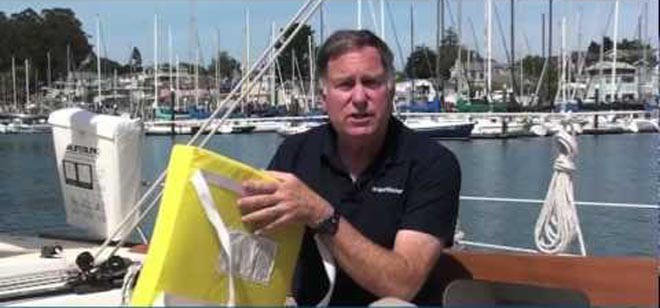Ten Boat Safety Checks Every Skipper Needs to Make
by John Jamieson on 7 Nov 2012

Do YOU have a safety check-list somewhere prominently displayed on your boat? SW
Do you have a safety check list over the chart table on your boat - or anywhere else? Have you added the three most important bilge pumps to your boat safety check list? Does your sailing crew know the location of survival equipment, fuel shutoff valve and how to test a seacock?
John Jamieson (Captain John) suggests making these ten items your first stop when you step aboard any boat, power or sail. Develop your own checklist, but be sure to transfer these 'top ten' to the head of the line.
1. Fire Extinguishers:
Fire on a boat means big trouble. Check marine fire extinguisher locations and gauge charges. Recharge any extinguisher where the dial points into the red sector. Point out the location of each portable fire extinguisher to your crew. Remove dry powder extinguishers from their brackets once each sailing season. Invert them and shake the powder; it tends to cake near the bottom. Then reinstall them in their brackets. Now you know your extinguishers will serve you well in case of an emergency.
2. Flare Kits:
All items in your emergency flare kit have two stamped dates: a manufactured date (earlier) and expiration date (later). If they’re expired, keep the old ones, but you must replace them with new ones. Flares save lives, so keep them accessible and ready to use in an instant.
3. Stuffing Box:
More boats sink from leaking stuffing boxes than most any other cause. At the dock, a mooring or at anchor—not underway! Get your flashlight and shine it onto the packing and lock nuts. Water lubricates the packing, so you should see a drop or two every minute. Excessive leaks indicate worn or missing packing. Address this right away before you cast off.
4. Bilges and Engine Drip Pan:
Check the forward and aft bilge for excess water. Look for leaks around keel bolts or transducer through-hulls. Expect a normal accumulation of about one inch of bilge water from condensation.
Look under the engine in the drip pan. If you see water, dip your fingers in and rub them together. Clear, oily water indicates a fresh water coolant problem. But it could also signal a stuffing box leak. When you fire up the engine, keep an eye on the stuffing box for too much leakage.
5. Engine Fuel Shutoff:
Make sure you know the location of the fuel supply shutoff valve. In an emergency, you need to turn this off to stop fuel flow to your small diesel engine. Trace the fuel line between tank and primary fuel filter. Test the valve to make sure you can turn it off and on with moderate pressure.
6. Marine Seacocks:
Seacocks with frozen handles or blown hoses can sink a boat fast. Every seacock aboard must have a handle that works. Test each handle in the shut off and open position. A gentle tap with a mallet or hammer frees up most handles that are frozen from corrosion. Buy soft-wood tapered plugs and tie them to the base of each seacock. In an emergency, they’ll plug a leak.
7. Head Valves:
Another boat sinker. The head seacock often stays open underway. With a defective valve, this could cause the commode to fill and overflow. Make it a habit to shut off both valve and seacock after every use to prevent this problem. Make up a small placard and post it just above the head to remind users.
8. Port, Hatch and Cowl Closure:
Do the opening ports and hatches secure all the way? In a squall, spray or rainstorm, you must button her up below. Do you know where the cowl vent cover is? A dry cabin pumps up crew morale, second only to a hot meal!
9. Marine Bilge Pumps:
All mechanical type bilge pumps, please move to the back of the line! What you want here are the trusty 'works-every-time' manual type bilge pumps. Check for a large capacity manual bilge pump, like the whale pumps, in the cockpit. Find the handle and throw it in the sink to keep it handy.
Portable hand pumps are effective with a 3 foot hose (minimum) or longer hose on the intake and exhaust side. Make sure you have a bailing bucket or two aboard, too. They’ve kept more than one boat afloat when other methods failed.
10. Battery Covers and Tie Downs:
Most sailboats have two batteries, one to start the engine and one for general (house) electronics. Each battery must have a cover and a strong tie down to prevent movement when you heel. Test the cables for tight contact to the battery terminals. Now you know they’ll give you juice when you ask for it.
Take the time to go through these 10 boat safety checks before you get underway from pier, mooring or anchorage. Keep your cruising sailing season safe and satisfying for you and your sailing crew.
John Jamieson (Captain John) with 25+ years of experience shows you the no-nonsense cruising skills you need for safer sailing worldwide. Visit his website at www.skippertips.com for a free issue of the highly popular 'Captain John's Sailing Tips' newsletter.
Discover how you can gain instant access to hundreds of sailing articles, videos, e-Books and more!
If you want to link to this article then please use this URL: www.sail-world.com/103583